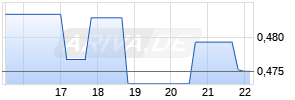
Vista Gold Corp. Announces Process Flowsheet Changes to Generate Better Gold Recoveries and Lower Operating Costs at Mt Todd
PR Newswire
DENVER, Colo., Nov. 28, 2016
DENVER, Colo., Nov. 28, 2016 /PRNewswire/ -- Vista Gold Corp. ("Vista", the "Company," "we" or "our") (NYSE MKT: VGZ) (TSX: VGZ) today announced the results of process area optimization studies that have the potential to enhance the project economics for the Mt Todd gold project in Northern Territory, Australia. The anticipated economic improvements are the result of process flowsheet changes that are expected to produce higher gold recoveries and lower process area operating costs. Testing indicates that these objectives can be accomplished through selectively screening and rejecting sub-economic, coarse crusher product prior to grinding; resulting in opportunities for improved gold recovery through finer grinding and improved operating costs down-stream of the grinding circuit.
A conference call with management to discuss the results of the Mt Todd gold project optimization studies is scheduled for Tuesday, November 29, 2016 at 2:00 pm MST.
Summary of Process Area Optimization Results
Earlier this year, Vista completed an independent review of the Mt Todd gold project. The combined input of the independent consultants and the project management team resulted in additional comminution and metallurgical recovery evaluations. These evaluations assessed opportunities to selectively remove below cut-off grade material from the process circuit after crushing. This results in less material being processed in the grinding and leaching circuits. The reduction in material results in excess grinding capacity which can be used to achieve a finer grind size in the final product and a corresponding increase in gold recovery for the remaining portion of the leach feed. Achieving the finer grind size is not expected to materially change the total grinding costs. Most importantly, the higher gold recovery is expected to increase cash flow, while the leaching, cyanide detoxification and tailings management costs are expected to decrease as a result of the reduction in the volume of material processed.
We completed size distribution and assay analysis of the high pressure grinding rolls ("HPGR") crusher product. This indicates that screening the HPGR crusher product at 5/8" produces an oversize product that accounts for 15-20% of the weight, but contains only 7-9% of the gold. Subsequently, we completed test work with Tomra Sorting Solutions, Inc. ("TOMRA") at their facilities in Germany to evaluate the recovery of sulfide/quartz/calcite-bearing material using Laser Reflection/Fluorescence and X-ray Transmission ("XRT") automated sorting techniques. This test work indicates that approximately 85% of the gold in this oversize fraction can be efficiently recovered with a return of 30-40% of the weight. We expect this to translate into an 11.5% reduction in material to be processed in the grinding/leaching circuits with a 1.6% loss in gold coming from the elimination of sub-economic material from the process stream.
If there is an 11.5% reduction in material passing to the grinding circuit, we expect to achieve a final grind size of 80% passing ("P80") 75 microns ("μm"), approximately 17% finer than the final grind size used in our May 2013 PFS of 90 μm. Test work confirms that at a P80 75 μm grind size, we can expect to achieve gold recoveries in the range of 83-84%, up from the 81.7% reported in the May 2013 PFS.
Vista's President & CEO, Frederick H. Earnest commented, "The process improvements that we have identified have the potential to generate lower operating costs and better gold recoveries without adding materially to the capital costs of the project. These improvements, coupled with the current US dollar to Australian dollar exchange rate have the potential to produce a significant improvement in project economics. We are now evaluating an update of our preliminary feasibility study."
Detailed Discussion of Metallurgical Testing Program Results
Mt Todd Deposit Geology
The Mt Todd deposit is hosted by a silicified sequence of greywackes, siltstones and shales. This host is cross-cut (nearly perpendicular to the bedding planes) by two different series of quartz and calcite veins. The injection of quartz- and calcite-rich solution provided the transportation mechanism for the gold and other sulfide minerals found in the deposit. The gold in the Mt Todd deposit is associated with the veining and occurrence of sulfide minerals, and is found only in small concentrations (likely the result of micro-fracturing) in the host rock. The quartz/calcite veining is pervasive throughout the deposit with vein thicknesses running from a couple of millimeters to several centimeters. Vein density can vary from 3-4 to 10-15 veins per meter. Selective assaying was completed to assess the presence of gold exclusively in the veins and/or sulfides compared to the host rock. Selective samples submitted to Pine Creek Labs in Pine Creek, Northern Territory, Australia indicated that carefully selected veins and sulfide samples contained 0.16-41.4 grams Au/tonne of sample compared to 0.05-0.46 grams Au/tonne of sample for the host rock. The relatively small proportions of vein/sulfide material account for the average grade of the deposit, and at the same time highlight the value of efforts to separate the host rock from the gold-bearing veins and sulfides.
HPGR Product Screen-size and Gold Distribution Analysis
In 2012, we prepared two bulk samples representative of the Mt Todd deposit using metallurgical core dispersed across the deposit (identified as M1 and M3). These two samples were sent to Thysen Krupp Industrial Solutions' HPGR testing facilities in Germany for HPGR crushing tests. A total of approximately two tonnes of material between the two composites was crushed. The HPGR crushed material was returned to Vista for subsequent metallurgical testing. Using HPGR crushed material from these two composites, we undertook studies to evaluate the amount of material and amount of gold contained in various screen size fractions. The results of this analysis are summarized in the following table. This work (including the subsequent sample prep) was completed by Resource Development Inc. of Wheatridge, Colorado ("RDi") with assaying completed by Florin Analytical Services in Reno, Nevada.
| | M1 Sample | M3 Sample | ||||||||
| | Wt% | Au (g/mt) | % | Cumulative | Au (g/mt) | Wt% | Au | % | Cumulative | Au (g/mt) |
| Feed | 100 | 0.92 | 100 | ----- | ----- | 100 | 0.79 | 100 | ----- | ----- |
| +7/8" | 6.6 | 0.71 | 5.1 | 94.9 | 0.93 | 4.3 | 0.67 | 3.7 | 96.3 | 0.79 |
| 7/8" x 5/8" | 13.1 | 0.53 | 7.5 | 87.4 | 1.00 | 11.7 | 0.4 | 6 | 90.3 | 0.85 |
| 5/8" x 3/8" | 19.8 | 1.19 | 25.8 | 61.6 | 0.93 | 17.2 | 0.87 | 19.1 | 71.2 | 0.84 |
| 3/8" x 1/4" | 12.6 | 0.92 | 12.7 | 48.9 | 0.93 | 12.7 | 0.72 | 11.7 | 59.5 | 0.87 |
| -1/4" | 47.9 | 0.93 | 48.9 | ----- | ----- | 54.1 | 0.87 | 59.5 | ----- | ----- |
Based on this data and with some understanding of the minimum size requirements for selective automated sorting we determined that the 5/8" screen oversize provided a meaningful volume of material for our testing to evaluate selective sorting and rejection. This size was also selected because it is reasonable to expect that screening can be effectively achieved at this size in a full scale operation. Physical observation of the +5/8" material indicated visually identifiable portions of vein material and sulfide material. It was noted that the majority of the 5/8" material showed no visual indications of veining or sulfides.
Automated Sorting Testing
Automated sorting is employed by many industries, and in the gold sector the Coeur Kensington mine is successfully operating an automated sorting circuit to recover higher grade ore before wasting the rejects. Many different sensors are used today in sorting, including but not limited to: Optical, Laser, XRT, Near Infrared, Visible light, Electromagnetic, and Color. A sample of +5/8" oversize material was sent to TOMRA's mining sorting division for testing. Testing was performed under the supervision of Outotec personnel using XRT and Laser sorting sensors. Testing indicates that a combination of XRT and Laser sorting methods could effectively identify the material containing quartz/calcite veining and/or sulfide material for subsequent removal using automated air sorting technology. A larger sorting test is planned to verify the promising indicative results. The following table summarizes the results of test work completed by TOMRA under Outotec supervision at TOMRA's mining sorting division in Germany.
| | | | Grade | % Distribution | ||
| | | Wt % | Gold (g | Total Sulfur (%) | Gold | Sulfur |
| Average Feed (Calculated) Werbung Mehr Nachrichten zur Vista Gold Aktie kostenlos abonnieren
E-Mail-Adresse
Bitte überprüfe deine die E-Mail-Adresse.
Benachrichtigungen von ARIVA.DE (Mit der Bestellung akzeptierst du die Datenschutzhinweise) -1  Vielen Dank, dass du dich für unseren Newsletter angemeldet hast. Du erhältst in Kürze eine E-Mail mit einem Aktivierungslink. Hinweis: ARIVA.DE veröffentlicht in dieser Rubrik Analysen, Kolumnen und Nachrichten aus verschiedenen Quellen. Die ARIVA.DE AG ist nicht verantwortlich für Inhalte, die erkennbar von Dritten in den „News“-Bereich dieser Webseite eingestellt worden sind, und macht sich diese nicht zu Eigen. Diese Inhalte sind insbesondere durch eine entsprechende „von“-Kennzeichnung unterhalb der Artikelüberschrift und/oder durch den Link „Um den vollständigen Artikel zu lesen, klicken Sie bitte hier.“ erkennbar; verantwortlich für diese Inhalte ist allein der genannte Dritte. Andere Nutzer interessierten sich auch für folgende News | ||||||




